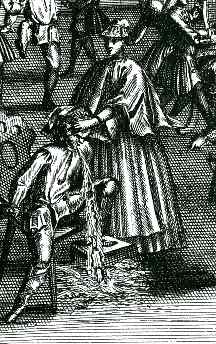The Woman Who Vomited Frogs
-
In 1642, Mrs. Catharina Geisslerin was widely known as "the toad-vomiting woman of Germany." She told people that she had swallowed tadpoles in swamp water, and that frogs were thriving in her intestinal tract. Whenever she drank milk, the frogs would hop about madly. Despite initial skepticism, she convinced physicians that amphibians were in her digestive system -- especially after she vomited fully-grown frogs (sometimes living) for two years in front of famous professors and medical consultants!
When Dr. Thomas Rheinesius, a great physician from Saxony, decided to study Catharina's case, she seemed to stop vomiting frogs. He wanted to examine her further, and for three months gave her various foul solutions to encourage her to vomit and have diarrhea. But no frogs came forth. Next, Professor Michaelis from Leipzig came to give Catharina more powerful agents to encourage vomiting -- which caused her to vomit a frog leg.
In 1648, after the physicians had left, Catharina began vomiting amphibians with a passion -- and the famous Thomas Bartholin was called in to study her. Bartholin, a student of the Dutch school of anatomists, was no slouch. He taught at the University of Copenhagen (1646-1661) and served as physician to King Christian V (reference 1). As mentioned previously, Bartholin was the first person to fully describe the entire human lymphatic system. If anyone could solve the mystery of the frog-vomiting woman, he could, or so people thought.
Bartholin started his research by cutting up one of Catharina's frog children. He was shocked to find dozens of black flies inside the stomach. How could this be if the frog had grown to maturity within the woman's belly? Like St. André who did not consider mature rabbit dung and floating lungs indicative of fraud, Bartholin did not think the flies meant Catharina swallowed frogs and vomited them in front of spectators a few minutes later.
When Catharina died in 1662, the medical community was excited about dissecting her body to search for amphibians within her stomach or intestines. To their dismay, the physicians found no creatures. Catharina did not die by amphibian overcrowding but by liver inflammation.
The scientists studying Catharina did not realize that the stomach's digestive juices would quickly destroy amphibians. (The warm temperature also contributes to their demise.) -
Throughout the 17th and 18th centuries, there were many stories of people vomiting amphibians, and most German pathological museums contained vomited amphibians that allegedly lived for years in a person's digestive tract. For example, in 1694, Theodorus Döderlein of southern Germany vomited 21 newts and 4 frogs (see Figure). In 1834, Mrs. Henriette Pfenning vomited frogs in front of applauding crowds of spectators. (She later admitted her hoax -- she stashed the frogs inside her skirt pockets and pretended to vomit the frogs.)

Theodorus Döderlein vomits frogs and newts.
(From Georg Abraham Mercklin's De Incantamentis, 1715.)
Why did these individuals swallow creatures only to vomit (or pretend to vomit) them in front of crowds? (reference 2) No doubt much of it was for attention, although it is possible that obsessive compulsive disorder played a role in some cases. People afflicted with obsessive-compulsive disorder perform endless odd rituals that dominate their daily lives. For example, trichotillomaniacs continuously pull out their hair. Other people with obsessive-compulsive disorder continually wash their hands, check if a door is locked, perform rituals while going through doorways, etc. Almost all people afflicted with obsessive-compulsive disorder recognize their problems and therefore often keep their embarrassing diseases hidden.
The most extreme case of compulsive swallowing is that of a 42-year-old woman who, in 1927, complained of a "slight abdominal pain." Physicians removed 2,533 objects from her stomach including 947 bent pins. In 1985, physicians removed 212 objects from a man whose stomach contents included: 53 toothbrushes, 2 razors, 2 telescopic aerials, and 150 handles of disposable razors. -
I just don't understand. Why can't those people just eat sandwiches like normal people?
-
beats me.......frog porridge??